MARKET OVERVIEW
The global gas treating chemicals market is a very specialized niche under the overall oil and gas sector. This market revolves around the production, sales, and application of chemical compounds that are necessary in the preparation of natural gas for use, processing, or carriage. These chemicals serve to eliminate impurities such as hydrogen sulfide, carbon dioxide, and water vapor, which cause destruction of facilities or reduce the quality of fuel. The market itself is functional in a strategic sense, not only in extraction areas but also in areas where infrastructure for processing energy relies almost solely on upholding rigorous quality control standards. Demand for these chemical reagents will increasingly be shaped over time by project-specific requirements and not by broad, sweeping global trends.
This is a market influenced by the technical issues of working with raw gas streams. Every gas field has a distinct chemical composition, so treatment approaches have to be extremely specialized. The more sour and complex gas fields are developed, the more solutions will develop in accordance with technical specifications. Hence, suppliers in this industry will not just provide off-the-shelf products but also engage with gas processors closely to develop solutions that will fit one-of-a-kind field conditions. That adaptive strategy will shape the market's competitive advantage in the future.
What distinguishes the global gas treating chemicals market is its profound integration into industrial processes, as opposed to consumer applications. It works unobtrusively with upstream and midstream operations, acting as a behind-the-scenes facilitator of effective energy flow. Refineries, petrochemical facilities, and even LNG terminals will rely on these chemicals to run within safe and compliant boundaries. It's not a sector that comes into the spotlight beyond industry circles, but its significance will become increasingly apparent as regulatory regimes become more stringent around emission levels and gas purity standards.
As opposed to wider markets that could rely on marketing or branding to push recognition, this market will remain dependent on technical performance and logistical reliability. Purchasers are generally engineers or procurement experts, not typical consumers, and this defines the sales cycle to be one where long-term dependability is more important than marketing messages. Innovation is measured and deliberate here, with an eye towards cleaner separations, reduced reactivity, and greater process compatibility.
As energy infrastructure grows over new geographies, the global gas treating chemicals market will extend, insinuating itself into startup schemes as well as facility upgrades. Chemical formulations will be called upon to work in varied environmental conditions—deserts, offshore rigs, arctic installations—each requiring a different balance of stability, reactivity, and efficiency. Suppliers that can foresee these conditions in advance by testing and field trials will be best placed to construct enduring contracts.
This market will not be characterized by mass consumer trends and buzzwords but by its ongoing function of facilitating reliable gas supply chains. Field operators, project managers, and chemical engineers will still be the audience. In brief, the global gas treating chemicals market will not pursue visibility but quietly expand with infrastructure, fueling energy systems most will never notice.
Global gas treating chemicals market is estimated to reach $6,849.53 Million by 2032; growing at a CAGR of 5.0% from 2025 to 2032.
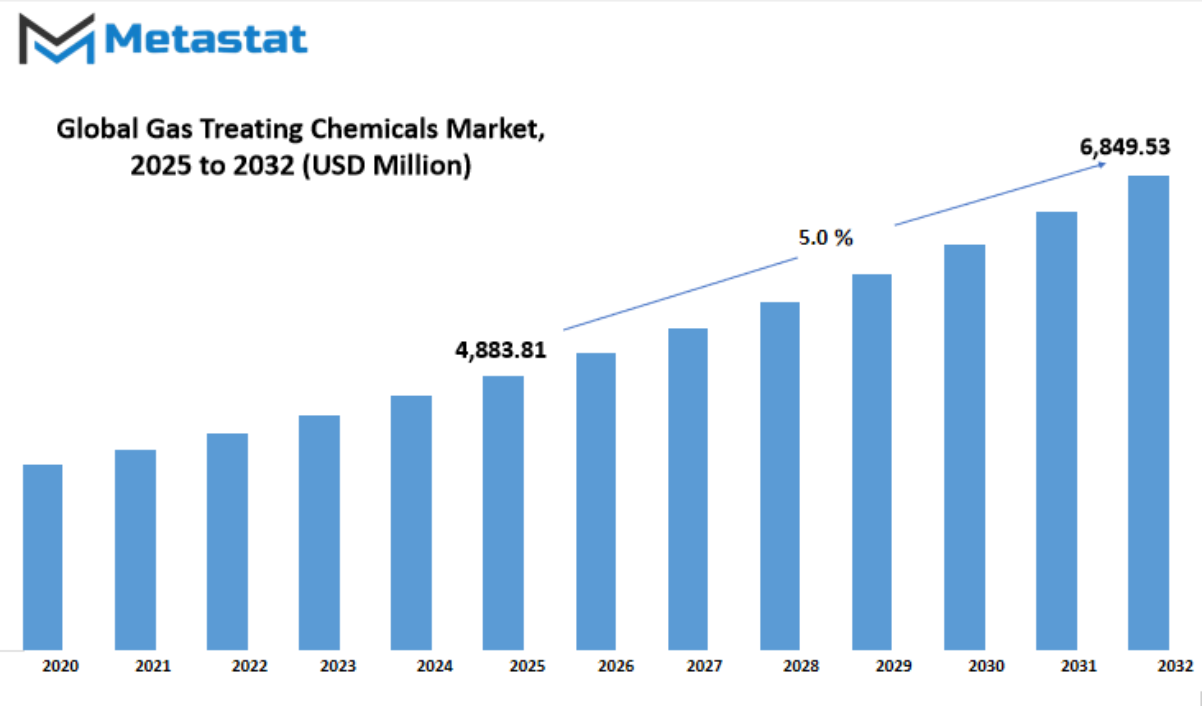
GROWTH FACTORS
The global gas treating chemicals market is expected to grow steadily as industries focus more on cleaner energy solutions and compliance with environmental regulations. One of the main reasons behind this growth is the increasing demand for purified natural gas. As countries aim to reduce their dependence on coal and crude oil, natural gas has become a preferred alternative because it burns cleaner and emits fewer pollutants. This shift means that natural gas must be treated to remove impurities such as carbon dioxide, hydrogen sulfide, and water vapor before it can be used or transported. Gas treating chemicals play a major role in this purification process, and their use will likely increase as the demand for cleaner fuel rises across the globe.
Another major reason the global gas treating chemicals market will continue to expand is the worldwide development of oil and gas infrastructure. Many countries are investing heavily in building new pipelines, refineries, and processing plants. This ongoing expansion boosts the need for effective gas treatment to maintain the safety and efficiency of operations. More processing facilities mean more chemicals are needed to ensure the gas meets quality standards and environmental guidelines. Also, as new regions begin to explore and develop their natural gas reserves, demand for advanced gas treatment solutions will rise further.
Still, there are challenges that could slow down the market's progress. Fluctuating crude oil prices affect both upstream exploration and downstream refining projects. When prices are unstable, oil and gas companies tend to delay investments, which may reduce the demand for gas treating chemicals temporarily. Additionally, there are growing concerns about the environmental impact of chemical discharge and handling. Stricter rules around how these substances are stored, used, and disposed of could lead to higher compliance costs and limit the use of certain products.
However, these same concerns open up new possibilities for innovation. One promising area is the development of gas treating chemicals that are both eco-friendly and more efficient. Companies that can create solutions with less environmental impact while still performing effectively will likely see high demand. These advancements could help balance the need for cleaner energy with environmental protection, making the global gas treating chemicals market more sustainable in the long term.
Looking ahead, the global gas treating chemicals market will likely grow as the energy sector evolves and cleaner energy solutions take center stage. Companies that adapt and innovate will have the advantage as the push for sustainability and efficiency continues.
MARKET SEGMENTATION
By Type
The global gas treating chemicals market is expected to play a vital role in shaping the future of the energy and environmental sectors. As demand for cleaner fuels continues to rise, there will be a growing need for effective gas treatment processes. These processes help remove impurities like carbon dioxide, hydrogen sulfide, and other contaminants from natural gas, ensuring that the gas meets quality and safety standards before it reaches consumers. With stricter regulations around emissions and environmental safety being enforced across various countries, companies are turning to gas treating chemicals as an essential part of their operations.
By type, the global gas treating chemicals market is segmented into Amines, Non-Amines, and Others. Amines have long been the most commonly used chemicals in gas treatment due to their strong performance in removing acid gases. They work well under different temperature and pressure conditions, making them a dependable choice. However, they do have limitations, especially with respect to corrosion and energy use. This is where Non-Amines are gaining attention. These newer formulations are designed to reduce environmental impact and improve operational efficiency. They often require less energy during processing and produce fewer emissions. In the coming years, the adoption of Non-Amines is expected to grow steadily as companies look for more sustainable solutions without sacrificing performance.
The "Others" category includes various emerging chemical technologies that are still being tested or recently introduced. These could bring new possibilities to the industry. Innovations in this segment may offer even greater efficiency, lower toxicity, and less wear on equipment, which will help companies extend the life of their assets and reduce maintenance costs. Over time, these alternatives may shift the market landscape, especially if they prove to be more cost-effective or if regulations push for less hazardous materials.
Looking forward, the global gas treating chemicals market will continue to evolve as energy producers try to balance cost, efficiency, and environmental responsibility. Technological progress will likely open up new ways to treat gas more cleanly and efficiently. This could lead to better custom-formulated chemicals tailored to specific field conditions or contaminants. In short, the market will grow not just in size but also in the quality of its solutions. As industries move toward a lower-carbon future, the demand for better, cleaner gas treating chemicals will become even more essential.
By Application
The global gas treating chemicals market is expected to grow steadily as energy needs continue to rise and industries seek cleaner and more efficient methods to manage gas emissions. These chemicals are vital in removing impurities like hydrogen sulfide, carbon dioxide, and other unwanted gases. Their use makes processed gas safer for the environment and more suitable for further use. The demand for these chemicals will likely expand as more countries enforce strict emission rules and invest in cleaner energy solutions. Across many sectors, these chemicals are already playing a key role in meeting environmental standards and improving operational safety.
One area where gas treating chemicals are making a clear impact is in power plants. As countries aim to switch to cleaner energy, natural gas has become a popular alternative to coal. But to use natural gas effectively, it must first be treated to remove harmful components. The need for gas treating chemicals in power plants will likely grow as more plants are built or converted to run on gas. Similarly, refineries depend on these chemicals to process crude oil into usable fuels. With growing demand for fuels and tighter regulations, the use of these chemicals in refineries will continue to be important.
In the pulp and paper industry, these chemicals help manage gases released during the production process. This not only protects the environment but also improves workplace safety. As this industry continues to modernize and grow in regions like Asia-Pacific, the use of gas treating chemicals will become even more widespread. In the metal and mining sector, these chemicals are used to handle gas emissions from extraction and smelting processes. Their role will become even more important as mining activities increase to meet the demand for minerals used in new technologies.
The food and beverage industry, though not always associated with gas treatment, also uses these chemicals to ensure that gases used in packaging and processing are pure and safe. Oil and gas remain major users of these chemicals, especially in upstream and midstream processes. As drilling moves into more complex areas, the need for advanced gas treating methods will rise. Even the sugar industry, which uses gas in processing, relies on these chemicals to ensure product quality and safety. Looking ahead, the global gas treating chemicals market will keep evolving, shaped by new technologies, changing rules, and the global push for cleaner industries.
|
Forecast Period |
2025-2032 |
|
Market Size in 2025 |
$4,883.81 million |
|
Market Size by 2032 |
$6,849.53 Million |
|
Growth Rate from 2025 to 2032 |
5.0% |
|
Base Year |
2024 |
|
Regions Covered |
North America, Europe, Asia-Pacific Green, South America, Middle East & Africa |
REGIONAL ANALYSIS
The global gas treating chemicals market shows a pattern of steady growth across multiple regions, each bringing different opportunities and challenges to the table. Looking ahead, this regional distribution will continue to shape how companies approach expansion and innovation. North America, which includes the U.S., Canada, and Mexico, plays a leading role. The U.S. alone has a strong industrial base and advanced oil and gas operations, which will likely keep driving demand for efficient and cost-effective gas treating chemicals. With a growing focus on environmental rules and cleaner fuel processing, companies in this region are expected to keep improving their chemical solutions to match stricter emission standards.
Europe, with countries like the UK, Germany, France, and Italy, is likely to focus more on sustainability. Governments in this area have already shown a strong push toward greener practices, and that trend is expected to continue. As the global gas treating chemicals market there shifts toward reducing carbon footprints, gas treating chemicals that help support low-emission production will become more important. Businesses in Europe will probably invest more in research to create products that support this greener direction, especially with increasing pressure from environmental groups and new policies.
Asia-Pacific, which includes China, India, Japan, and South Korea, stands out for its fast-growing energy needs. As these economies expand, the need for energy security and stable supply chains will become even more pressing. This will drive more investment into gas treatment facilities and chemicals that help improve safety and reduce waste. China and India, in particular, will see growth due to their large populations and increasing demand for cleaner energy sources. As these countries work on cutting pollution, they will likely turn to updated gas treatment methods supported by efficient chemical solutions.
In South America, nations such as Brazil and Argentina have been working to improve their energy infrastructure. Their efforts to use local resources more efficiently and reduce dependence on imports will lead to a steady rise in the use of gas treating chemicals. Though the pace might be slower than in other regions, the long-term outlook remains positive as these countries aim to modernize.
The Middle East & Africa, including places like the GCC Countries, Egypt, and South Africa, will continue to be important due to their oil and gas reserves. As they try to maintain their global role while also preparing for a future less dependent on oil, the focus will shift toward better and cleaner gas treatment methods.
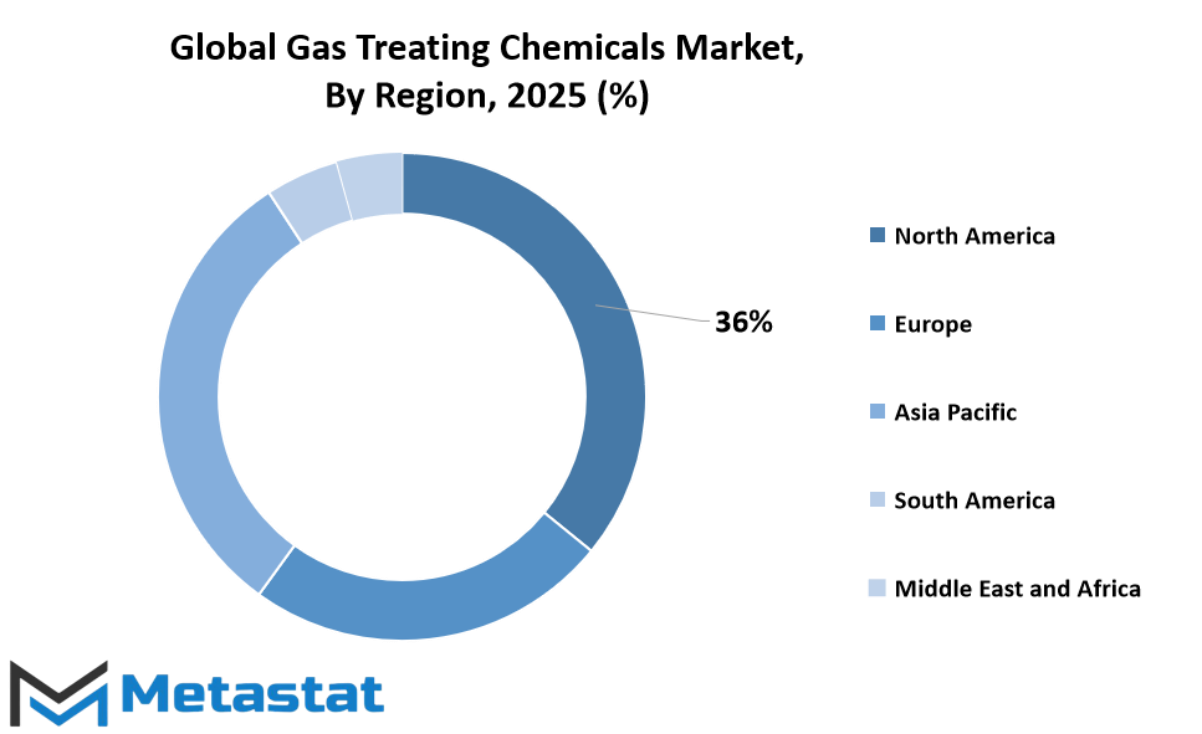
COMPETITIVE PLAYERS
The global gas treating chemicals market will continue to see a shift as energy demands increase and cleaner fuel alternatives gain more attention. As nations work towards reducing carbon emissions and ensuring more sustainable industrial practices, the need for effective gas treating solutions will grow steadily. These chemicals are used in processes that remove unwanted gases like hydrogen sulfide and carbon dioxide from natural gas, which is essential to make it safe and suitable for commercial use. As industries expand their natural gas infrastructure, both in developed and developing countries, the demand for these chemicals is expected to rise significantly.
In the years ahead, more innovations will shape how companies produce and apply gas treating chemicals. Environmental regulations are getting stricter, and industries will have to adapt by using products that are both efficient and less harmful. This means chemical producers will be investing in research and development to create formulations that can perform well while leaving a smaller footprint. The global gas treating chemicals market will likely see more companies adopting smart technologies to monitor chemical use and reduce waste. Automation, digital tracking, and data analysis are expected to play a larger role in making these operations more streamlined.
The competitive landscape is marked by companies that are already known for their influence in the chemical industry. Major players such as BASF SE, Huntsman Corporation, Dow Inc., and Evonik Industries AG will continue to lead the way. These firms have the resources to invest in new technology and expand their global presence. Meanwhile, Clariant AG, Baker Hughes, Shell Chemicals, and Schlumberger Limited are also focused on developing innovative solutions that meet the growing demand for efficiency and environmental responsibility. Smaller but impactful companies like Eunisell Limited are making their mark by offering niche solutions and focusing on specific regional markets.
As energy markets evolve, companies in the global gas treating chemicals market will need to remain flexible and responsive. Success will depend not only on producing effective chemicals but also on building strong relationships with energy providers and governments. With pressure mounting to meet both economic and environmental goals, collaboration and innovation will become even more important. Over the next decade, competition will grow stronger, and companies that adapt quickly will likely secure a larger share of this expanding market.
Gas Treating Chemicals Market Key Segments:
By Type
- Amines
- Non-Amines
- Others
By Application
- Power Plants
- Refineries
- Pulp & Paper
- Metal & Mining
- Food & Beverages
- Oil & Gas
- Sugar
Key Global Gas Treating Chemicals Industry Players
- BASF SE
- Huntsman Corporation
- Dow Inc.
- Evonik Industries AG
- Clariant AG
- Baker Hughes
- Shell Chemicals
- Schlumberger Limited
- Nalco Champion (Ecolab)
- Akzo Nobel N.V.
- Exxon Mobil Corporation
- Eunisell Limited
WHAT REPORT PROVIDES
- Full in-depth analysis of the parent Industry
- Important changes in market and its dynamics
- Segmentation details of the market
- Former, on-going, and projected market analysis in terms of volume and value
- Assessment of niche industry developments
- Market share analysis
- Key strategies of major players
- Emerging segments and regional growth potential



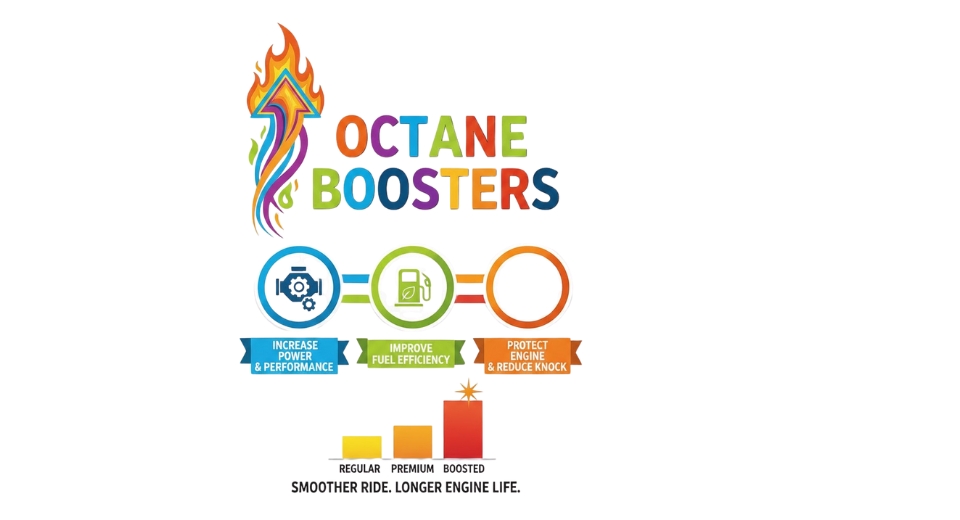

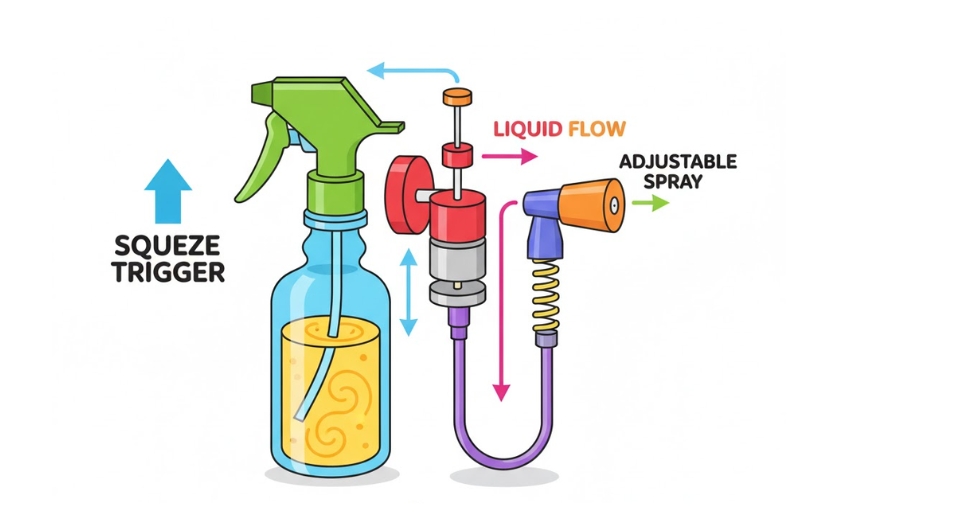
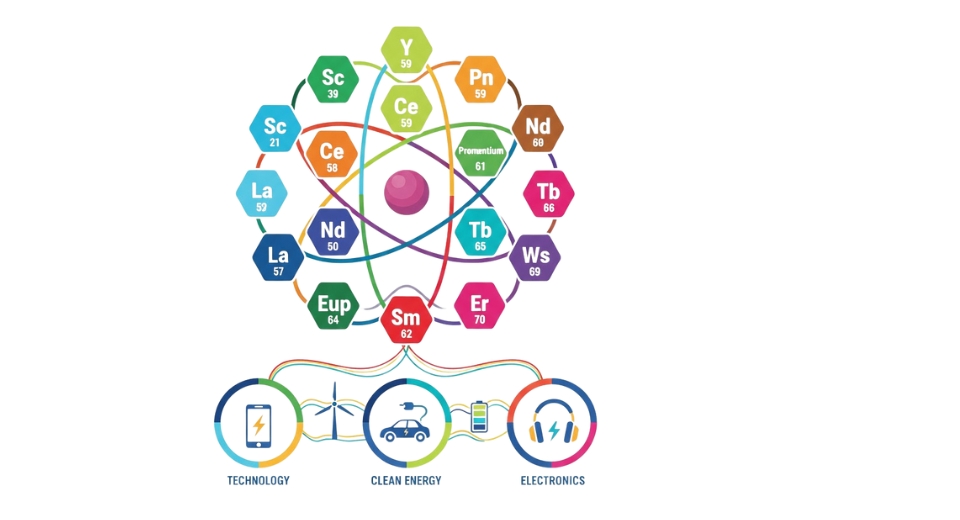

 US: +1 3023308252
US: +1 3023308252






